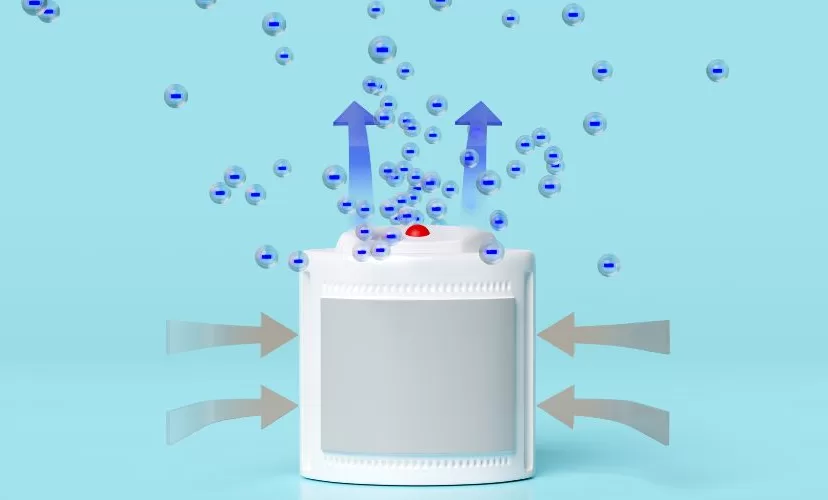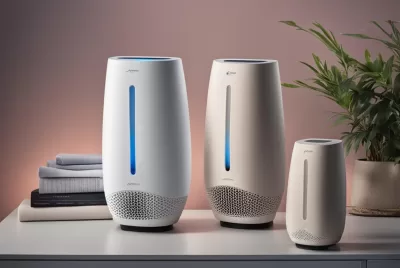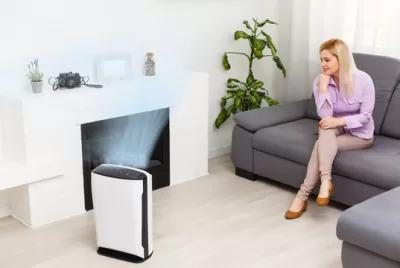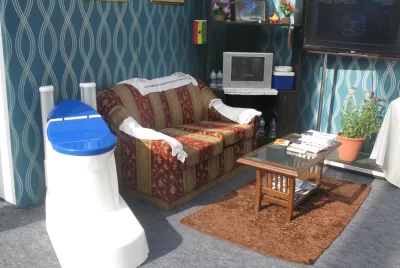Debunking Myths: Do Air Purifiers Really Work?
"We may earn a commission for purchases made using our links. Please see our disclosure to learn more."
Do Air Purifiers Really Work? Dive into the Truth.
In today’s health-focused world, many ask: Do air purifiers work? With COVID-19, wildfires, and pollution, clarity is needed.
Air purifiers promise cleaner air, targeting dust and pollen. They’re beneficial, but not a complete solution. In this guide, we’ll reveal their true value.
Diving right in, one cannot talk about air purifiers without mentioning HEPA filters. Known for their prowess in capturing tiny particles, they’re a game-changer. However, a word to the wise: steer clear of terms like “HEPA-type” or “HEPA-style.” These may not adhere to the strict industry standards true HEPA filters abide by. And while HEPA filters are champions against many pollutants, they aren’t entirely virus-proof.
On the other hand, the carbon filter, an unsung hero, does wonders in trapping gases and volatile organic compounds (VOCs) that often escape from household items. Modern-day air purifiers up the ante with sensors, giving you real-time air quality insights. The tech-savvy ones even connect to your phone, keeping you informed and in control.
But here’s the real deal: Can air purifiers boost your health? The answer lies in shades of grey. For those battling asthma or allergies, an air purifier can be a valuable ally. The British Lung Foundation suggests that for those with confirmed pet allergies, air purifiers can indeed diminish airborne allergens. Still, expecting them to be the ultimate health remedy would be an overreach.
Our goal here is to provide clarity and dispel misconceptions. By the time you finish this exploration, you’ll be well-equipped to discern the true value of air purifiers in enhancing indoor air quality. Ready to unveil the myths and realities of air purifiers? Let’s embark on this enlightening journey.
Do Air Purifiers Really Work? Unmasking the Truth.
As our world contends with challenges like the pandemic, wildfires, and escalating traffic pollution, the quest for pristine indoor air has never been more pertinent. Amidst this backdrop, air purifiers have emerged as sought-after devices, pledging to combat common airborne adversaries. But the pivotal question lingers: Do air purifiers really work? Let’s sift through the haze and uncover the facts.
The Science Behind Air Purifiers:
At their core, air purifiers are designed to enhance indoor air quality by diligently filtering out contaminants. The crown jewel of these devices is the High-Efficiency Particulate Air (HEPA) filter. A marvel in air purification, HEPA filters excel at intercepting pollutants, even those as minuscule as 0.3 micrometers, promising you a breath of fresh air in your sanctuary.
HEPA Filters: The Allergen Assassins
Venturing deeper, the prowess of HEPA filters becomes evident. Tasked with the mission to combat everyday allergens – think dust mites, pet dander, and pollen – these filters operate via a meticulous mesh. This mesh acts as a sentinel, trapping unwanted particles and ensuring they don’t make an unwelcome return to your living space. For those in the grip of allergies or respiratory ailments, HEPA-equipped air purifiers might just be the relief they seek.
Empirical Evidence: Air Purifiers under the Microscope
But don’t just take our word for it. The efficacy of air purifiers stands tall, fortified by robust research. A notable investigation from the Journal of Allergy and Clinical Immunology revealed a promising correlation: homes with HEPA filters witnessed diminished indoor allergens, translating to alleviated asthma symptoms. Similarly, the Environmental Protection Agency (EPA) attested to the prowess of portable air cleaners equipped with HEPA filters, underscoring their capability to curtail particulate matter indoors.
In summation, science and studies converge on a compelling narrative: air purifiers, especially those brandishing HEPA filters, are formidable allies in the fight for superior indoor air quality, fostering respiratory wellness and holistic well-being.
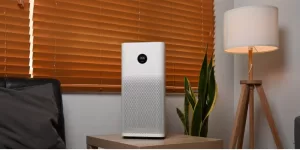
In conclusion, air purifiers do work and have been proven to be effective in filtering out allergens and pollutants from indoor air. By understanding how air purifiers function, the role of HEPA filters in capturing allergens, and the scientific research behind their effectiveness, you can make an informed decision about incorporating an air purifier into your home to improve air quality and potentially alleviate allergy symptoms.
Myth #2: Understanding the Continuous Air Cleaning Process
One of the common misconceptions about air purifiers is that they only clean the air temporarily and do not provide long-term benefits. However, this is a myth that needs to be debunked. Air purifiers are designed to provide continuous air cleaning, ensuring that the air in your home is consistently purified.
Continuous Air Cleaning Process
Air purifiers utilize various technologies to remove pollutants from the air. HEPA filters, for example, effectively capture particles as small as 0.3 microns, including dust, pollen, pet dander, and even some bacteria and viruses. These filters work by forcing air through a fine mesh, trapping the contaminants and preventing them from recirculating into the room.
In addition to HEPA filters, some air purifiers also use activated carbon filters to absorb gases, odors, and volatile organic compounds (VOCs). This makes them effective at eliminating unpleasant smells and reducing exposure to harmful chemicals commonly found in household products.
Air purifiers equipped with air-quality sensors take the purification process a step further. These sensors detect pollutants in the air and automatically adjust the purifier’s settings to maintain optimal air quality. They provide real-time feedback on the air quality in your home, giving you peace of mind and assurance that the air you breathe is clean and healthy.
The Long-term Benefits of Using Air Purifiers
Investing in an air purifier offers a range of long-term benefits for both your health and overall well-being. By continuously purifying the air in your home, air purifiers can:
1. Reduce allergens: For individuals with allergies, air purifiers can significantly reduce the presence of allergens like pollen, pet dander, and dust mites. This can alleviate symptoms such as sneezing, wheezing, and itching.
2. Improve respiratory health: Air purifiers help remove airborne particles that can irritate the respiratory system, making it easier to breathe for those with asthma or other respiratory conditions.
3. Enhance sleep quality: Cleaner air means fewer irritants that can disrupt sleep, resulting in better sleep quality and reducing the likelihood of respiratory issues during the night.
4. Mitigate the effects of secondhand smoke: Air purifiers with activated carbon filters can help reduce the presence of harmful smoke particles and odors from cigarettes or cooking, benefiting both smokers and non-smokers alike.
5. Promote general well-being: Breathing clean air has a positive impact on overall health and well-being, improving energy levels, concentration, and overall quality of life.
Testimonials and User Experiences
Many individuals who have incorporated air purifiers into their daily lives have reported positive experiences and noticeable improvements in their indoor air quality. Testimonials from satisfied users often highlight:
Reduction in allergy symptoms:
Allergy sufferers have reported a significant reduction in symptoms such as sneezing, congestion, and itchy eyes after using air purifiers consistently.
Better sleep:
Users have noticed improved sleep quality and wake up feeling refreshed, thanks to cleaner air free from allergens and irritants.
Decreased respiratory issues:
Individuals with asthma or other respiratory conditions have reported fewer flare-ups and breathing difficulties when using air purifiers regularly.
Elimination of unpleasant odors:
Air purifiers equipped with carbon filters have effectively eliminated odors from cooking, pets, and other sources, creating a fresher and more pleasant indoor environment.
These testimonials highlight the tangible benefits that air purifiers can bring to your home and your health. The continuous air cleaning process ensures that you can enjoy the long-term advantages that cleaner air provides.
Remember, while air purifiers offer numerous benefits, it’s essential to select a model that suits your specific needs and consider the size and features that best address your concerns. Let’s move on to debunking another common myth about air purifiers.
Source: U.S. Environmental Protection Agency
Myth #3: Noise Levels of Modern Air Purifiers
Noise levels of modern air purifiers
When considering an air purifier for your home, the noise level is an important factor to consider. Modern air purifiers are designed to operate quietly, allowing you to enjoy clean air without any disturbance. These appliances utilize advanced technologies to minimize noise production, ensuring a peaceful environment in your living space.
How to choose a quiet air purifier
To select a quiet air purifier, there are a few key factors to consider. First, look for models that are specifically advertised as “quiet” or “low noise.” Manufacturers often provide noise level specifications for their products, measured in decibels (dB). Aim for an air purifier with a noise level below 50 dB for a quiet operation that won’t disrupt your daily activities or sleep.
Additionally, consider the size of the room where the air purifier will be placed. Opt for a model with a higher Clean Air Delivery Rate (CADR) that matches the room size. A higher CADR ensures efficient air filtration, allowing the air purifier to operate at lower fan speeds, which in turn reduces noise.
Lastly, customer reviews can provide valuable insights into the noise levels of specific air purifier models. Look for feedback from customers who have used the purifier in real-life settings to get an idea of how quiet or noisy it is in practice.
Customer reviews on noise levels
Many customers appreciate the efforts made by manufacturers to reduce noise levels in modern air purifiers. In customer reviews, you’ll often find positive feedback regarding the quiet operation of these appliances. People highlight how they can run the air purifier continuously in their bedrooms or workspaces without being disturbed by excessive noise.
It’s worth noting that noise perception can vary from person to person, so what may be considered quiet for one individual might be slightly louder for another. However, overall, the general consensus among customers is that modern air purifiers are designed to operate quietly, providing a peaceful and undisturbed environment.
In conclusion, noise levels in modern air purifiers are typically minimal, allowing for smooth and uninterrupted operation. By choosing a quiet air purifier that matches your room size and considering customer reviews, you can enjoy the benefits of clean air without any undue noise.
Myth #4: The Range of Air Purifier Prices and Cost-benefit Analysis
One of the common misconceptions about air purifiers is related to their price and the cost-benefit analysis of owning one. Let’s delve into the range of air purifier prices, the potential cost savings, and the long-term benefits of investing in an air purifier.
The Range of Air Purifier Prices
Air purifiers come in a wide range of prices, depending on various factors such as brand, features, and technology. Entry-level air purifiers can be found for as low as $50, while high-end models can reach prices upwards of $1,000.
The price variation can be attributed to the quality of the filters, the efficiency of the purification system, the coverage area, and additional features such as smart connectivity and air quality sensors. It’s essential to consider your specific needs and budget when deciding which air purifier to purchase.
Cost-benefit Analysis of Owning an Air Purifier
Now, let’s discuss the cost-benefit analysis of owning an air purifier. While the initial cost may seem like a significant investment, it’s crucial to consider the potential benefits and savings in the long run.
1. Improved Health and Well-being: Air purifiers can help remove airborne allergens, dust particles, pet dander, and other pollutants, leading to improved indoor air quality. This can be especially beneficial for individuals with allergies, asthma, or respiratory conditions, as it may reduce symptoms and improve overall health.
2. Reduced Medical Expenses: By minimizing exposure to pollutants, air purifiers can potentially reduce the frequency and severity of allergy and asthma symptoms. This, in turn, could lead to lower medical expenses, including doctor visits, medication costs, and allergy shots.
3. Increased Productivity: Clean air promotes a healthier and more productive environment. By removing pollutants and improving air quality, air purifiers can create a space that is conducive to concentration, focus, and overall well-being. This can be particularly beneficial for home offices or workspaces.
4. Odor Control: Some air purifiers feature activated carbon filters that are effective in reducing odors caused by cooking, tobacco smoke, pets, or other sources. This can enhance the overall freshness and cleanliness of your indoor environment.
Energy Efficiency and Long-term Savings
Now let’s touch on the energy efficiency and potential long-term savings associated with air purifiers.
1. Energy Efficiency: Many modern air purifiers are designed to be energy-efficient. Look for air purifiers with an ENERGY STAR certification, as these are specifically engineered to consume less power without compromising performance. Additionally, some models have adjustable fan speeds or automatic sensors that optimize energy usage based on air quality.
2. Long-term Savings: While the upfront cost of an air purifier may vary, the long-term savings can be substantial. By improving indoor air quality, you may experience reduced maintenance costs for HVAC systems, as cleaner air puts less strain on filters and ductwork. Moreover, a healthier environment may contribute to fewer sick days and increased productivity, resulting in potential financial gains.
When considering the cost-benefit analysis of owning an air purifier, it’s essential to evaluate your specific needs, budget, and the potential long-term benefits that align with your requirements. Remember to choose an air purifier that suits your space and addresses your primary concerns regarding indoor air quality.
Image insert
Myth #5: The Importance of Ventilation and Regular Cleaning
One common myth about air purifiers is that they can replace the need for proper ventilation and regular cleaning in maintaining indoor air quality. While air purifiers are effective in filtering out pollutants, they do not address the root cause of indoor air pollution.
Ventilation and Regular Cleaning for Indoor Air Quality
Proper ventilation is crucial for maintaining healthy indoor air quality. It helps to remove stale air and bring in fresh outdoor air, diluting pollutants and preventing them from accumulating. Opening windows, using exhaust fans, and ensuring adequate airflow in your home are all important steps in promoting good ventilation.
Regular cleaning is another essential aspect of maintaining clean indoor air. Dust, pet dander, mold spores, and other pollutants can settle on surfaces and contribute to poor air quality. Regular dusting, vacuuming, and mopping can help reduce the presence of these particles and prevent their circulation in the air.
Complementing Existing Cleaning Practices with Air Purifiers
Air purifiers can be a valuable addition to your existing cleaning practices. While ventilation and regular cleaning help remove pollutants from surfaces, air purifiers work to filter out airborne particles, such as dust, pollen, and pet dander, effectively reducing their presence in the air you breathe.
By incorporating an air purifier into your cleaning routine, you create a multi-layered approach to indoor air quality. While ventilation and cleaning tackle the sources of pollutants and their accumulation, air purifiers can provide continuous filtration, capturing smaller particles that may escape regular cleaning efforts.
Expert Recommendations on Maintaining Indoor Air Quality
Experts recommend a combination of proper ventilation, regular cleaning, and the use of air purifiers to maintain optimal indoor air quality. Each of these measures plays a vital role in combating indoor air pollution and reducing the potential health risks associated with it.
Air purifiers complement, not replace, proper ventilation and cleaning. Pair them with HEPA filters for optimal results. For the best air quality, combine ventilation, cleaning, and air purifiers. This trio ensures a healthier home.
Inseert Image
Conclusion
Decoding the Efficacy of Air Purifiers: The Final Verdict
As we come to the end of our exploration into air purifiers, the evidence stands undeniably strong: air purifiers make a marked difference in enhancing indoor air sanctity. By skillfully sieving out airborne adversaries and allergens, they pave the way for a reduced risk of respiratory challenges and allergic reactions.
Yet, a word to the wise: not all air purifiers don the same mantle of efficacy. Their prowess can fluctuate, influenced by nuances like the space they serve, the technological marvel they harness, and the dedication to their upkeep. The onus, then, is on the discerning consumer. Seek out a top-tier air purifier tailored to your unique circumstances.
Steer clear of misconceptions and myths clouding the air purifier narrative. Anchor your faith in the robust science backing their benefits. For those seeking a breath of pure, untainted air in their homes or workplaces, a trustworthy air purifier might just be the investment of a lifetime.

